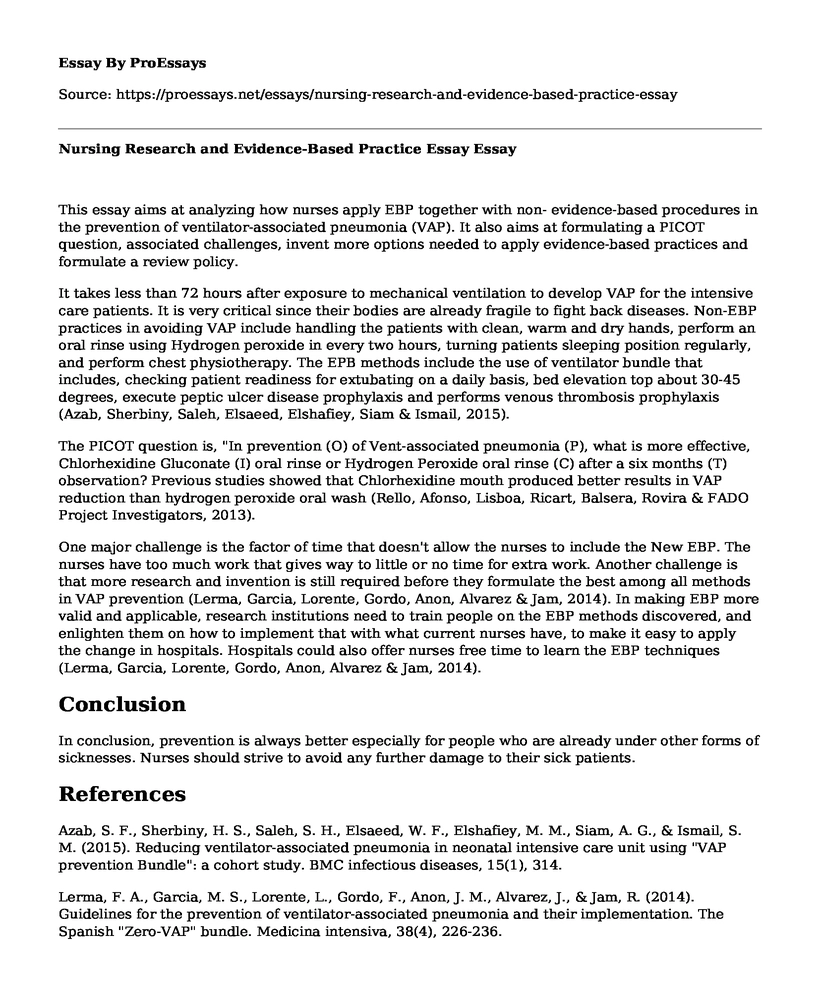This essay aims at analyzing how nurses apply EBP together with non- evidence-based procedures in the prevention of ventilator-associated pneumonia (VAP). It also aims at formulating a PICOT question, associated challenges, invent more options needed to apply evidence-based practices and formulate a review policy.
It takes less than 72 hours after exposure to mechanical ventilation to develop VAP for the intensive care patients. It is very critical since their bodies are already fragile to fight back diseases. Non-EBP practices in avoiding VAP include handling the patients with clean, warm and dry hands, perform an oral rinse using Hydrogen peroxide in every two hours, turning patients sleeping position regularly, and perform chest physiotherapy. The EPB methods include the use of ventilator bundle that includes, checking patient readiness for extubating on a daily basis, bed elevation top about 30-45 degrees, execute peptic ulcer disease prophylaxis and performs venous thrombosis prophylaxis (Azab, Sherbiny, Saleh, Elsaeed, Elshafiey, Siam & Ismail, 2015).
The PICOT question is, "In prevention (O) of Vent-associated pneumonia (P), what is more effective, Chlorhexidine Gluconate (I) oral rinse or Hydrogen Peroxide oral rinse (C) after a six months (T) observation? Previous studies showed that Chlorhexidine mouth produced better results in VAP reduction than hydrogen peroxide oral wash (Rello, Afonso, Lisboa, Ricart, Balsera, Rovira & FADO Project Investigators, 2013).
One major challenge is the factor of time that doesn't allow the nurses to include the New EBP. The nurses have too much work that gives way to little or no time for extra work. Another challenge is that more research and invention is still required before they formulate the best among all methods in VAP prevention (Lerma, Garcia, Lorente, Gordo, Anon, Alvarez & Jam, 2014). In making EBP more valid and applicable, research institutions need to train people on the EBP methods discovered, and enlighten them on how to implement that with what current nurses have, to make it easy to apply the change in hospitals. Hospitals could also offer nurses free time to learn the EBP techniques (Lerma, Garcia, Lorente, Gordo, Anon, Alvarez & Jam, 2014).Conclusion
In conclusion, prevention is always better especially for people who are already under other forms of sicknesses. Nurses should strive to avoid any further damage to their sick patients.
References
Azab, S. F., Sherbiny, H. S., Saleh, S. H., Elsaeed, W. F., Elshafiey, M. M., Siam, A. G., & Ismail, S. M. (2015). Reducing ventilator-associated pneumonia in neonatal intensive care unit using "VAP prevention Bundle": a cohort study. BMC infectious diseases, 15(1), 314.
Lerma, F. A., Garcia, M. S., Lorente, L., Gordo, F., Anon, J. M., Alvarez, J., & Jam, R. (2014). Guidelines for the prevention of ventilator-associated pneumonia and their implementation. The Spanish "Zero-VAP" bundle. Medicina intensiva, 38(4), 226-236.
Rello, J., Afonso, E., Lisboa, T., Ricart, M., Balsera, B., Rovira, A., & FADO Project Investigators. (2013). A care bundle approach for prevention of ventilator-associated pneumonia. Clinical Microbiology and Infection, 19(4), 363-369.
Cite this page
Nursing Research and Evidence-Based Practice Essay. (2022, Mar 29). Retrieved from https://proessays.net/essays/nursing-research-and-evidence-based-practice-essay
If you are the original author of this essay and no longer wish to have it published on the ProEssays website, please click below to request its removal:
- Research Paper on Hypoglycemia
- Paper Example on Ensuring Adherence to ART among Latino Community
- Essay Sample on Euthanasia: A Complicated Discussion in Med, Phil and Public Forum
- Paper Example on Protection from Pregnancy Discrimination by OFCCP Rule
- Christianity and Abortion: A Complicated History - Essay Sample
- COVID-19 in the US: NY at the Epicenter of Pandemic - Essay Sample
- Essay Example on Food Security: Promoting Healthy Lives for All







